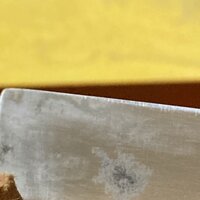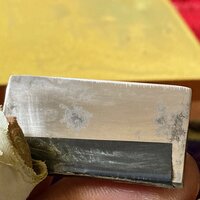Well, I am getting much better. My blades are getting wicked sharp and holding an edge (thanks, folks!) Now it is time to learn to address another issue. My hones are not even. I should say I am doing this on safety razor blades -- NOT the disposable ones, but stropping ones on vintage razors. The uneven wear always seems to be at the same place. I took a couple pics to show. this is in the middle of my hone. Always the same place on both sides. The right side (when you look at it) always has the proper amount, but as it moves to the left, it gets thin to nonexistent.
This is a pic mid-hone of one. I recently lapped the Norton 8000 stone I was using. The blade is a safety for a Thiers Issard set from the 1910's. The blade is now even. Most of the blades had horrible rust which I have gotten down to just the devil's tears, and it is ready to work on. This particular one is just an example of the uneven line I am getting.
I have not been honing in the strop holder at this point, instead just taping the spine until I get to the 12000 stone. And I have already evened out the edge on a 4000 stone. I have been altering between a little extra pressure on that side and a little less to see which one corrects the results and I do not seem to be getting what I am looking for. I have been more frequently lapping the stone and that has not helped. What adjustment do I need to make to my technique to correct this?


This is a pic mid-hone of one. I recently lapped the Norton 8000 stone I was using. The blade is a safety for a Thiers Issard set from the 1910's. The blade is now even. Most of the blades had horrible rust which I have gotten down to just the devil's tears, and it is ready to work on. This particular one is just an example of the uneven line I am getting.
I have not been honing in the strop holder at this point, instead just taping the spine until I get to the 12000 stone. And I have already evened out the edge on a 4000 stone. I have been altering between a little extra pressure on that side and a little less to see which one corrects the results and I do not seem to be getting what I am looking for. I have been more frequently lapping the stone and that has not helped. What adjustment do I need to make to my technique to correct this?


